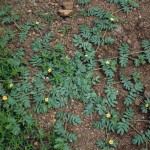Hairy Caltrop, Warty Caltrop
Kallstroemia hirsutissima
Zygophyllaceae (Caltrop family)
Description
Hairy caltrop is a much-branched annual with long, prostrate limbs emanating from a central root. Its growth habit and general appearance are very similar to goathead (puncturevine). Both are members of the caltrop family. The fruit of hairy caltrop is beaked, and at maturity it breaks up into eight to 12 one-seeded nutlets. Stems and leaves are conspicuously hairy; the beak of the fruit is no more than 3 millimeters long. A close relative to hairy caltrop is warty caltrop (K. parviflora). The plants are quite similar, with only slight differences in the fruits.
Habitat
Caltrops are typically found in old fields, disturbed areas and heavily grazed pastures. Both species are distributed widely across Texas. Hairy caltrop is more common in the western part of the state; warty caltrop is more common in the east. Hairy caltrop is also found in southeastern Arizona, southern New Mexico and Mexico. Warty caltrop can be found from Texas to California, north through Oklahoma, Kansas and Missouri to Illinois and Mississippi.
Toxic Agent
These plants are toxic to cattle, sheep, goats and rabbits. The toxic agent is unknown, although it is believed that an animal must eat about one-third of its weight in caltrop to be poisoned.
Signs of Livestock Ingestion
The first proven cases of cattle losses to hairy caltrop in the Trans-Pecos region of Texas were documented in 1944. The progression of signs in cattle and goats include: Weakness in the hind legs with knuckling of the fetlock joint; Posterior paralysis; Frequently, convulsions before death.
Sheep losses seem to be sporadic, with signs of illness similar to those in cattle, but sheep walk on their front knees before convulsions develop.
Management Strategies
No medicinal treatment is available to counteract caltrop poisoning. As soon as poisoning is suspected, move animals to pastures free of caltrop. Do not handle or drive affected animals excessively. Problems generally occur when pastures are overgrazed and no other forage is available. Proper range management practices can alleviate most problems associated with this plant. In general, do not graze areas where most of the forage is hairy or warty caltrop.
Images
Plant Characteristics
Seed Type: Fruit/Berry
Duration: Annual
Stem Texture: Hairy
Growth Habit: Forbs/Broadleaf
Leaf Shape
 : Pinnately Compound
: Pinnately Compound
Season: Warm
Distribution
 : 02 - Gulf Prairies and Marshes, 03 - Post Oak Savannah, 04 - Blackland Prairies, 05 - Cross Timbers and Prairies, 06 - South Texas Plains, 07 - Edwards Plateau, 08 - Rolling Plains, 10 - Trans-Pecos
: 02 - Gulf Prairies and Marshes, 03 - Post Oak Savannah, 04 - Blackland Prairies, 05 - Cross Timbers and Prairies, 06 - South Texas Plains, 07 - Edwards Plateau, 08 - Rolling Plains, 10 - Trans-Pecos
Distributions
Distribution refers to the ecological region in Texas that a plant has been found. You can also view a clickable map.
Book: Toxic Plants of Texas (B-6105)
Collection: Toxics
Livestock Affected: Cattle, Goats, Sheep
Livestock Signs: Convulsions, Delayed Signs, Incoordination




